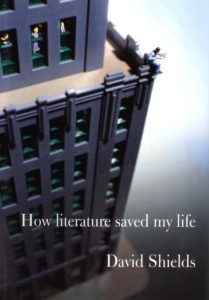It takes only a few pages of How Literature Saved My Life, David Shields’s fourteenth book, a genre-bending essay collection, to figure out that he is pushing an angle. And if you’ve read his previous, similarly difficult to define book Reality Hunger: A Manifesto, then you’ll know what it is before you even begin.
Here is the short version: Shields does not like stories, he likes feelings. He reads to seek out those feelings, and he finds the form of the traditional novel to be more or less a lot of fuss that ultimately obscures the real stuff of literature. In his own book, Shields attempts to do away with all the fluff of storytelling. He is in search of emotion in its most distilled form, and he wants literature to punch him in the stomach.
But there is something missing from How Literature Saved My Life. Shields writes: “A book should be an axe to break the frozen sea within us,” and “All great books wind up with the writer getting his teeth bashed in.” It’s a seductive position. It feels good to read those sentences, as I’m sure it felt good to write them. Still, all of Shields’s grand statements about what literature can and should do come together to make a book that is not doing that much.
Shields’s preferred form of writing is collage, and he fills his pages with quotes sewn together by his own thoughts. (Near the end of the book, he quotes writer and poet Sarah Manguso: “If there’s a good line in a book, I’ll happily copy out the line and sell the book to the Strand.”) Shields speaks with and through the writers he admires. How Literature Saved My Life is full of brief stories (a love note to a nude model, an unexpected momentary turn to God), and odes to books read. They are fragmentary narratives that knock up against moments of decontextualized emoting.
The title of the book, tongue-in-cheek but still on the cheesy side, fits the showing-all-my-cards-right-up-front ethos of the project. This book is about David Shields, the books that he likes, the way that he likes to write, and how things got to be that way. It is written for people like Shields, for whom the written word is as essential as water. Shields’s self-presentation as a geeky searcher — turning perpetually to literature to add cathartic vigor to his more quiet life experiences — is endearing, and his mostly lyrical and unencumbered writing winds its way through an impressive demonstration of literary knowledge. Shields’s narration of himself is engaging and highly enjoyable; his faith in literature is affirming and encouraging.
But How Literature Saved My Life, for all of its charm, also feels a bit throwaway, as though it might ultimately be not just a collage but a collage of the discarded scraps of Shields’s own previous work, which he refers to frequently. Some of the writing feels lazy: “An entire life, an entire way of thinking, comes to life,” for example, is clunky and banal. And at times Shields simply repeats things he has said before. He restates from Reality Hunger his controversial view that “The expository first chapter [of Slaughterhouse Five] renders moot the rest of the book and everything else [Vonnegut] ever wrote.”
Some recycling of ideas might be unavoidable and forgivable in the work of a writer who embraces collage as both an aesthetic and a way of thinking. Why come up with a new example if the old one still works? Shields argues that collage gets rid of unnecessary mediation, that writing “collage teaches a reader to understand that the movements of the writer’s mind . . . are the work’s meaning.” But in How Literature Saved My Life Shields collages in order to demonstrate collage. His mind moves to show how his mind moves, and I had the distinct feeling he was mostly following pathways he had been down before.
How Literature Saved My Life is full of references to unorthodox, semi-obscure personal writing, but Shields shares a particularly strong stylistic similarity to a young writer not mentioned in the book. Kate Zambreno, in her literary history-as-memoir Heroines, also has an intensely personal relationship with the writers whose work she channels and champions. She also writes in half sentences and scattered thoughts. She and Shields both have a penchant for repetition bordering on mantra. Both are hoping that the reader will draw lines to connect all their little shards of thought together. But while the style of Zambreno’s writing is essential to her project, it is not the point of the book. Zambreno has a story to tell and, while Heroines is far from perfect, she tells it in a way it has never been told before.
Finishing How Literature Saved My Life I am left wondering if disembodied emotion, with all surrounding plot and context removed, just boils down to something not much more meaningful than the authorless maxims pasted on photographs and distributed around the internet. (“Art is the last form of magic that exists!”)
Don’t get me wrong; this book has moments of real beauty. For anyone who loves to read, it is nourishing to listen to another person’s deeply felt conviction as to the utter indispensability of literature. But Shields adheres so closely to his expressed style that he reveals its limitations. Reading How Literature Saved My Life is kind of like talking to your friend over beers about how amazing that book you both just read was and how it restored your faith in the power of art. How Literature Saved My Life itself is not that book. At best it filters and refracts the potentials of literature. Yes, art is essential, we’re all going to die, love is an illusion. Now tell me a story.
This post may contain affiliate links.









